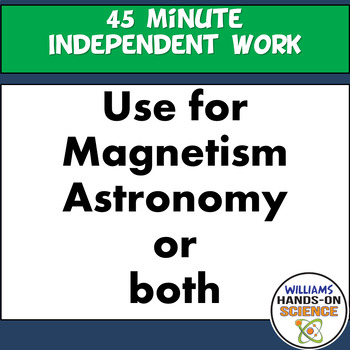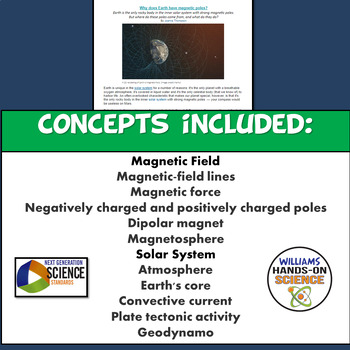Claim Evidence Reasoning CER Magnetism Astronomy Current Event NGSS Digital
- Zip
What educators are saying
Description
Students learn why Earth has a magnetic field through a C.E.R. (Claim Evidence Reasoning) graphic organizer. This is great for getting your students to explain phenomena in a meaningful way and it allows you as the instructor to adequately assess their understanding of concepts. The students figure out what the "Claim" is in the article, they then use data that supports the claim in the "Evidence" section, draw visual evidence and then explain why the evidence supports the claim in the "Reasoning" section.
The article has the following concepts:
Magnetic Field
Magnetic-field lines
Magnetic force
Negatively charged and positively charged poles
Dipolar magnet
Magnetosphere
Solar System
Atmosphere
Earth's core
Convective current
Plate tectonic activity
Geodynamo
Want to save a ton of money? Take a look at my CER Mega bundle!
Take a look at more CER’s in my store:
PS2.B: ESS1.B: Earth's Magnetic Poles are Moving Claim Evidence Reasoning CER
Claim Evidence Reasoning (CER): Autumn Equinox Can Fall on Different Days
NGSS Claim Evidence Reasoning (CER) Water Found on Mars
NGSS Black Holes & Galaxies Claim Evidence Reasoning Graphic Organizer
This is great for a current event, sub plan, homework, critical thinking, scaffolding and/or reinforcement of concepts!
You get a CER graphic organizer, an editable key, the article, tips for CER, a link to make it Google Ready, and the link to the website in the article.
NGSS Standards:
•Electric and magnetic (electromagnetic) forces can be attractive or repulsive, and their sizes depend on the magnitudes of the charges, currents, or magnetic strengths involved and on the distances between the interacting objects. (MS-PS2-3)
•Forces that act at a distance (electric, magnetic, and gravitational) can be explained by fields that extend through space and can be mapped by their effect on a test object (a charged object, or a ball, respectively). (MS-PS2-5)
ESS1.B: Earth and the Solar System
The solar system consists of the sun and a collection of objects, including planets, their moons, and asteroids that are held in orbit around the sun by its gravitational pull on them
SEP's Asking Questions and Defining Problem:
Students at any grade level should be able to ask questions of each other about the texts they read, the features of the phenomena they observe, and the conclusions they draw from their models or scientific investigations.
Engaging in Argument from Evidence:
In 9–12 builds on K–8 experiences and progresses to using appropriate and sufficient evidence and scientific reasoning to defend and critique claims and explanations about the natural and designed world(s). Arguments may also come from current scientific or historical episodes in science.
CCC's: Patterns
Observed patterns of forms and events guide organization and classification, and they prompt questions about relationships and the factors that influence them.
Cause and Effect
Empirical evidence is required to differentiate between cause and correlation and make claims about specific causes and effects.
TERMS OF USE
• All rights reserved by Williams Hands On Science, Inc.
• This product is to be used by the original purchaser only.
• Intended for classroom and personal use only.
• Copying for more than one teacher, classroom, department, school, or school system is prohibited.
• This product may not be distributed or displayed digitally for public view.
• Failure to comply is a copyright infringement and a violation of the Digital Millennium Copyright Act (DMCA).
If there are any errors or questions, please contact me through TpT or email me at:
williamshandsonscience@gmail.com
Thank you for taking a look!
Please follow me on TpT for new products and check me out on Instagram for my products in action!
https://www.instagram.com/williams_hands_on_science/





